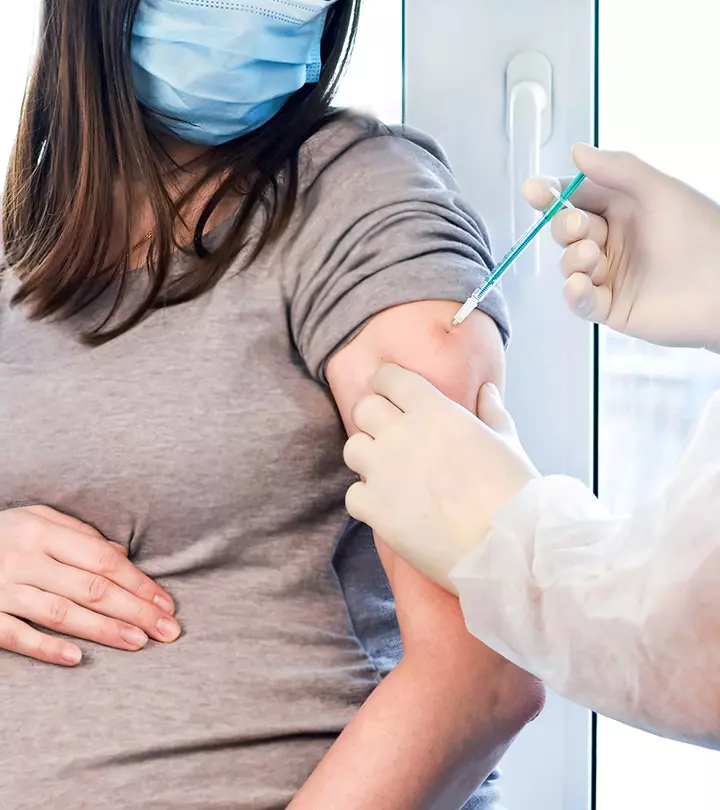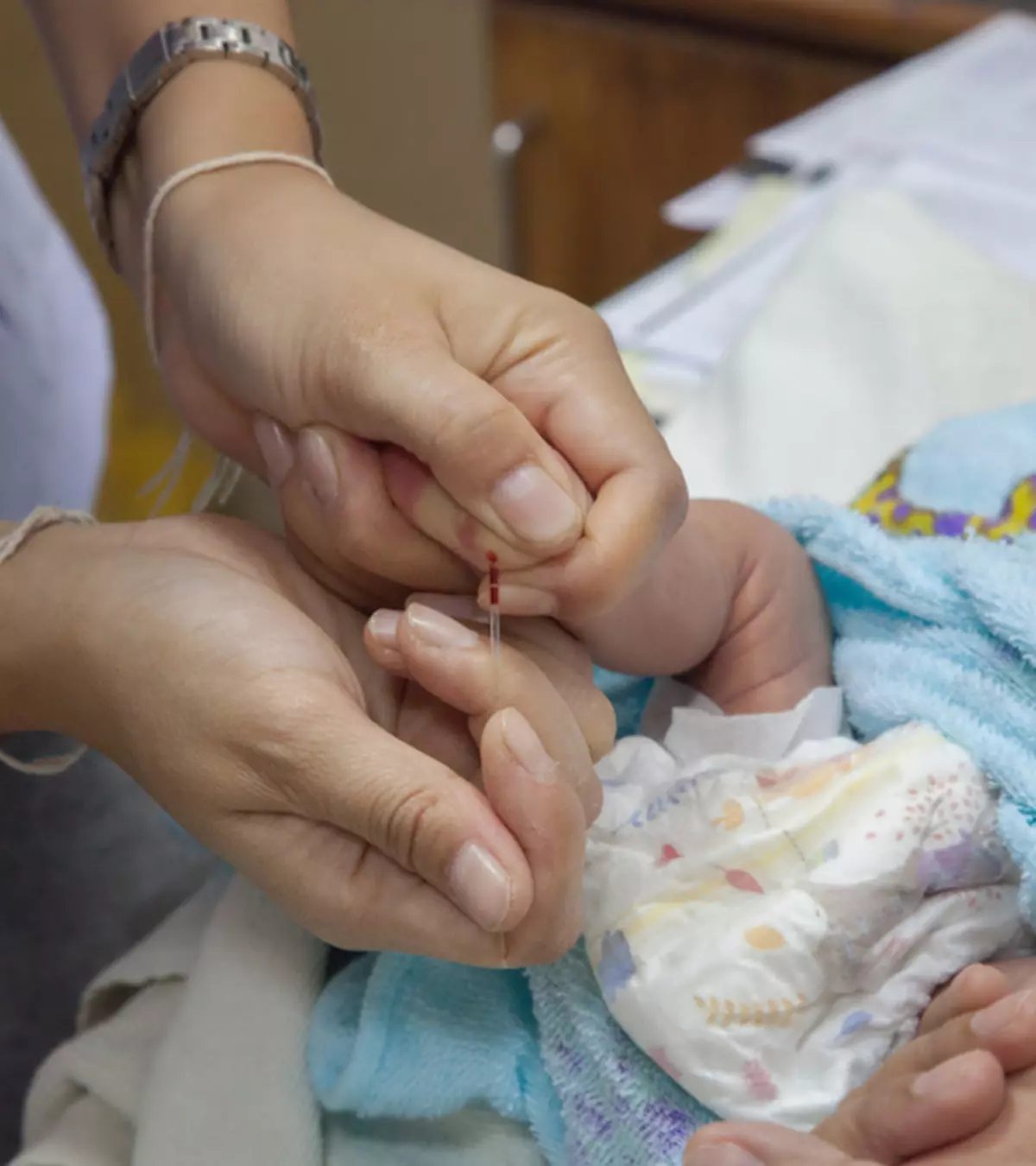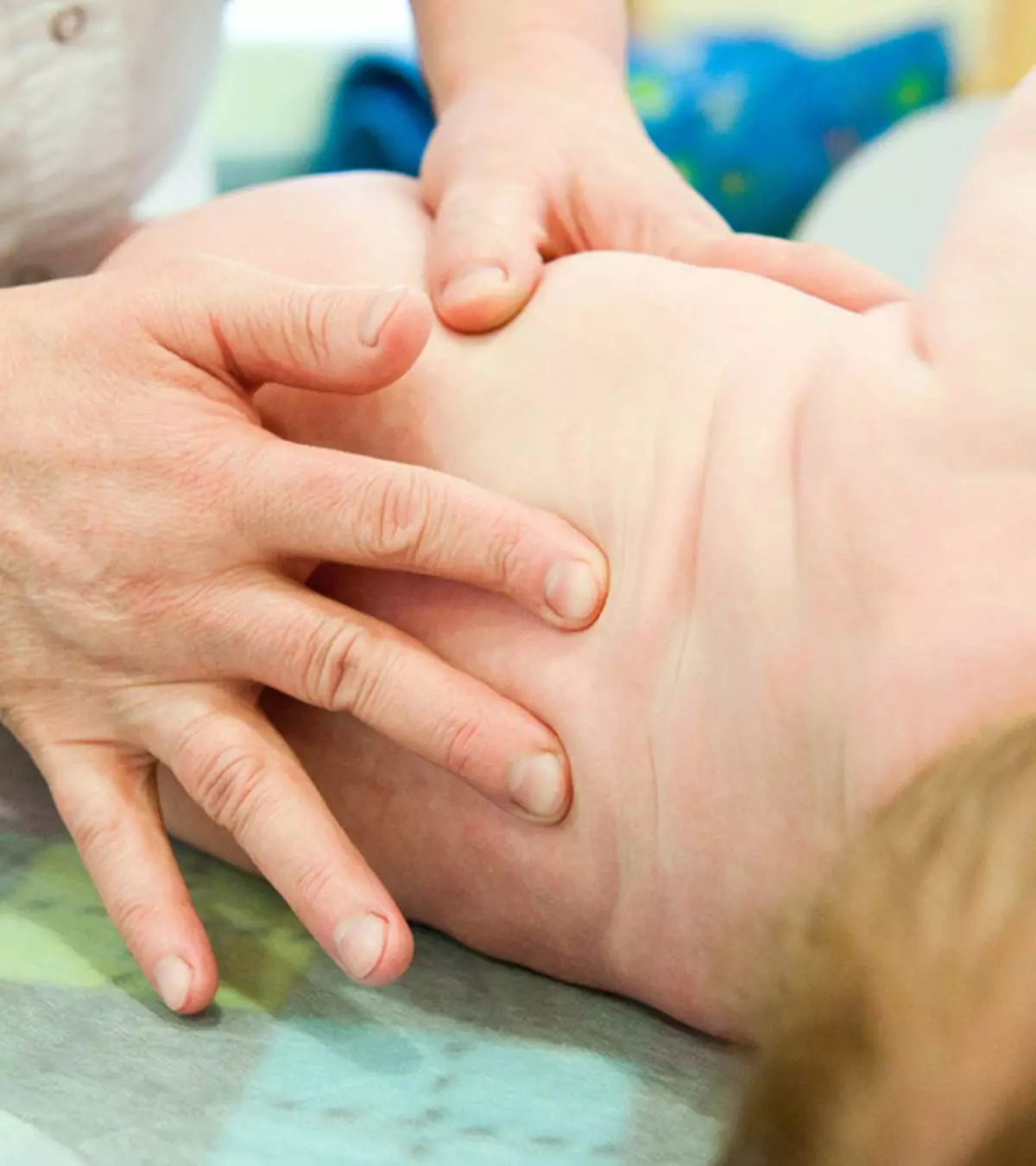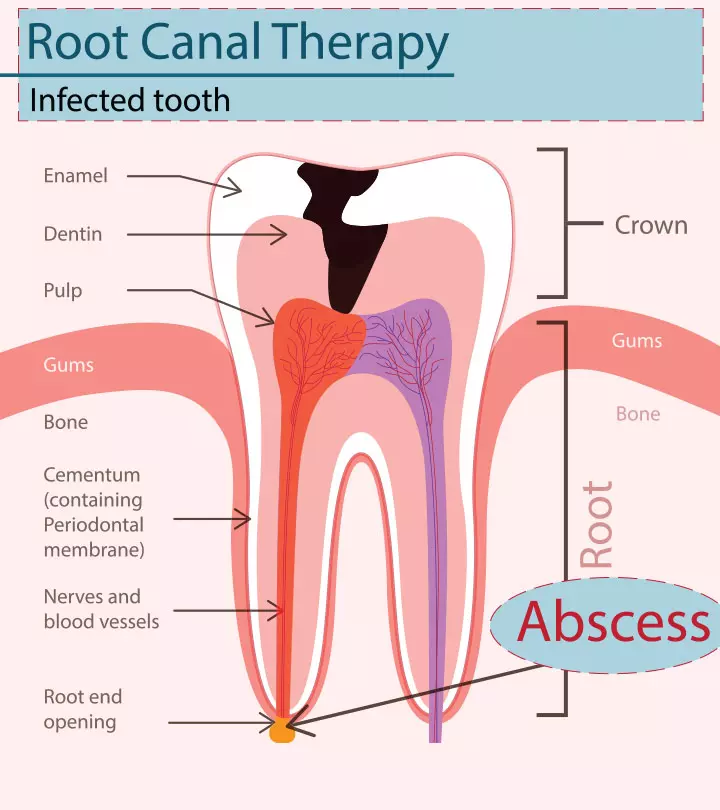
Image: Shutterstock
Spinal tap or lumbar puncture in babies is a process that involves the extraction of cerebrospinal fluid from the lower spine. This process is useful in the diagnosis of chronic illnesses. It is mostly done when doctors find it challenging to detect the reason for an illness through any other diagnostic test.

Read this post to learn more about lumbar puncture in babies, the reasons behind doing it, the side effects of the procedure, and how to care for your baby after the lumbar puncture is done.
Key Pointers
- Lumbar puncture or spinal tap is a procedure to remove cerebrospinal fluid from the lower spine using a syringe.
- It checks neural health and for pathogens in neural infections like sepsis, cancers, bacterial and viral diseases, and nervous system disorders.
- Lumbar puncture can cause headaches, injection wound infection, and accidental mixing of blood with the CSF.
- After extraction, parents must ensure the baby gets enough fluids and rest.
- If a baby has seizures, vomits, cries often, doesn’t eat or drink for a while, or is drowsy, contact the doctor.
What Is Lumbar Puncture?
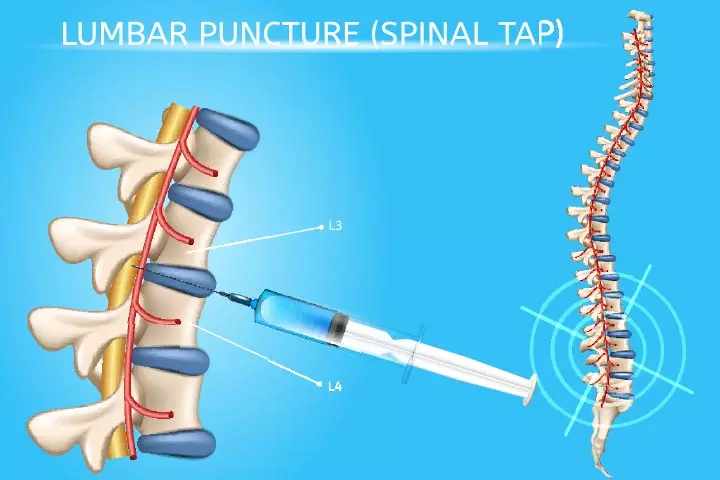
Lumbar puncture, also referred to as a spinal tap, is the process of inserting a syringe in the lower spine to extract cerebrospinal fluid (a clear liquid that circulates within the nervous system, carrying vital nutrients) (1). The fluid is drawn out from a cavity or pocket of cerebrospinal fluid that surrounds the entire nervous system.
Cerebrospinal fluid is significant because it can provide valuable insights into the health of the nervous system and display pathogens in the case of neural infection (2).
Why Is Lumbar Puncture Done?
Lumbar puncture or spinal tap is recommended when the doctor suspects a nervous system disorder, infection, or cancer (3). The fluid can be tested externally for anomalies or the presence of diseases. Sometimes, it could be the only way to determine the presence of certain infections. Following are scenarios where the spinal tap is recommended over general diagnostic procedures:
- Neonatal sepsis: It is a blood infection in infants caused by a host of diseases, including those that affect the nervous system, such as meningitisiSwelling and inflammation of the protective layers surrounding the brain and spinal cord caused by a bacterial or viral infection and encephalitisiSwelling of the brain caused by an infection, medicine, or autoimmune response leading to hallucinations, seizures, or a stiff neck (4). According to a systematic review published in the Archives of Disease in Childhood, the global incidence of neonatal sepsis was reported to be 2824 cases per 100,000 live births. If the doctor suspects the cause of sepsis to be an infection of the nervous system, then he would conduct a spinal tap to determine the presence of pathogens in the cerebrospinal fluid.
- Bacterial and viral infections: Microbes may find their way from blood or nerves to the cerebrospinal fluid, where they may harm the body by affecting the nervous system (5) (6).
Lindsay Boever, a mother, recounts how a lumbar puncture helped in ruling out spinal fluid infections in her daughter. Lourdes(her daughter) was moved for surgery after birth as the membrane surrounding the omphalocele had ruptured during the birth. During the following checkups, doctors found an infection and had to perform a lumbar puncture to determine if the infection had spread to her spinal fluid. She shares, “Blood test confirmed that she had developed a bacterial infection in her bloodstream…The next major concern was if the infection had spread to her spinal fluid, which could cause a whole host of additional problems like meningitis and brain damage. The next morning was met with another phone call from the NICU asking our permission to perform a lumbar puncture to rule out the spinal fluid concerns…She was so wound up that the doctors gave her morphine to calm her down during the procedure. Early results came back that the infection was not in her spinal fluid (i).”
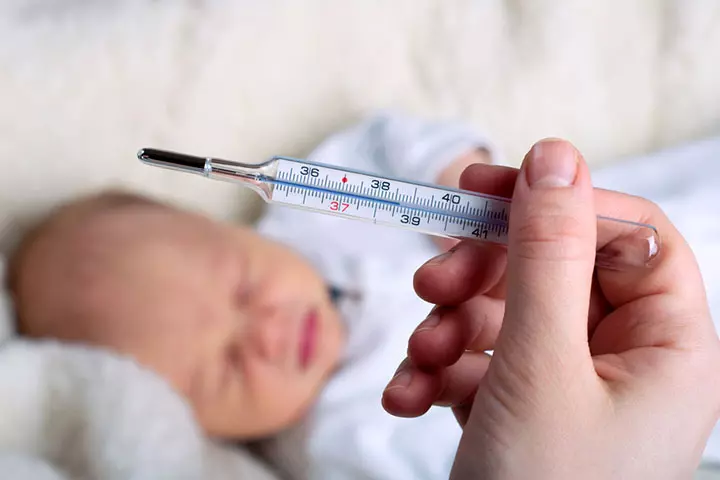
- Cancers: The cerebrospinal fluid can display the presence of cancerous cells if the baby has cancer such as leukemiaiAssociated with the white blood cells, it is a cancer of the blood-forming tissues such as the bone marrow that affects the blood, and lymphomaiCancer of the lymphatic system, the body’s defense system, that can be environmentally or genetically induced which could affect the nervous system or lymph nodes (7).
- Subarachnoid hemorrhage: It is the bleeding within the subarachnoid space, which lines the nervous system, including the brain. The presence of blood here can indicate hemorrhage, which can occur due to a head injury or due to an aneurysmiA defect in the artery causing it to swell up, which, if ruptured, can cause headache, pain, or even stroke . This causes the arterial walls to form a balloon-like pocket that bursts to leak blood into the surrounding tissue (8).
- Nervous system disorders: Lumbar puncture is a direct means of tapping into the nervous system to diagnose abnormalities or ailments. Degenerative neural diseases such as multiple sclerosisiA disorder of the central nervous system that causes problems of speech, coordination, and vision, numbness, and walking difficulties and Guillain-Barre syndromeiA rare autoimmune disorder that affects the nerves, resulting in muscle weakness or paralysis are determined through laboratory testing of cerebrospinal fluid, which can be obtained using the spinal tap procedure (9).
There are certainly other scenarios where a doctor may perform a lumbar puncture to inject a substance rather than extract fluids:
- Inject dye into the cerebrospinal fluid: Neuroimaging can be done through X-rays to observe the nervous system, but sometimes a special medical dye is injected into the subarachnoid space to help the doctor observe the X-rays of the nervous system better. This enables proper inspection of the spinal cord and associated nerves, which can be used to determine the presence of a disease (10).
- Injecting chemotherapy drugs: Lumbar puncture is utilized for the delivery of chemotherapy drugs in the nervous system or even other parts of the body in cases of cancer (11).
- Injecting medicines or anesthetics: Anesthetics can work faster if injected directly into the nervous system through a spinal tap. Doctors may also use lumbar puncture to inoculate the body with medicines in case they see it as the best means of administering the drug.
In some cases, the doctor may inject a needle to measure the intracranial pressure or pressure of the cerebrospinal fluid, using a medical device called a manometer. High cerebrospinal fluid pressure is a critical indicator of some diseases, such as meningitis (12).
While the procedure is important, it may have some side-effects too.
Side-Effects Of Lumbar Puncture
The side-effects of lumbar puncture may show up within hours of the procedure and last for a few days. They fade away as the injection site heals. Following are the lumbar puncture side-effects in babies:
- Headache: The baby could have a headache due to the change in cerebrospinal fluid pressure on the nervous system, making them irritable and cranky. Soothing, breastfeeding and cuddling should make them feel better. Babies are made to lie down in a head-low position for a few hours to avoid these pressure changes.

- Infection of the injection wound: When there is a lack of proper hygiene, the injection site may be attacked by bacteria, leading to the infection of the nervous system.
- Blood gets mixed with the extracted cerebrospinal fluid: If the baby is not held properly or if there is human error during the extraction process, some blood may get mixed with the cerebrospinal fluid. The fluid is then of no use since it cannot yield conclusive laboratory results. A repeat spinal tapping will be required, which is possible only after a few months.
These complications seldom happen, but you should still be vigilant about the appearance of any serious aggravation. Also, it is wise to have some information regarding the procedure so that you can stay prepared.
What Is The Procedure For Lumbar Puncture In Babies?
A spinal tap is conducted at the neurologist or pediatrician’s clinic, which should be well-equipped for the procedure. The process involves a series of steps:
1. Discussion with parents

The doctor explains the process and significance. He will also discuss the apprehensions over the procedure and assuage any concerns. Parents play a vital role in deciding the use of sedation.
Lumbar puncture is performed using local anesthesia, where the spot of injection stays numb, while the baby is alert. The doctor may even choose to give an intravenous sedative, which will make the infant drowsy.
The type of sedative would depend on the age and health of the infant as well as the preference of the parents.
2. The lumbar puncture procedure
On the day of the test, here is what the doctor does:
- The baby is made to lie on the side with their feet curled up and their arms in the front. The nurse or a parent can help the baby stay put in this position. The doctor will feel the spine of the baby to determine a gap in the lumbar region of the vertebral column. The for a lumbar puncture is between L3 and L4 or between L4 and L5 vertebra (13).
- Once the spot is determined, the doctor will rub it with a disinfectant solution, apply a cold gel on the area to partially numb the spinal nerve endings.
- The next step is to insert the lumbar puncture needle. The doctor determines the length of the lumbar puncture needle after considering the baby’s height, and age, and referring to the contemporary medical formulas (14). The needle is inserted into the lower back until it enters the subarachnoid space, which contains the cerebrospinal fluid.
- The puncture needle is hollow and has another needle within called a stylet. After the puncture, the stylet is gently withdrawn, drawing out the clear cerebrospinal fluid, and collecting it in test tubes. The fluid drips slowly, and it takes two to five minutes to complete the collection.
- The tapping needle is slowly retracted, and a sterile bandage is placed on the injection site.
Once the injection site is dressed, your baby can slowly move to the back and lie down the usual way. The entire procedure of pediatric lumbar puncture takes about 30 minutes (15).
Test results can be shared within hours or days, depending on the objective of spinal tapping. After the procedure, though, comes the crucial post-procedural care.
What Care Is Needed After Lumbar Puncture?
You need to take good care of the baby so that they can recover in the shortest time. Here are some points to remember after a lumbar puncture for an infant:
- Rest is essential: Your baby must sleep well for the next 24 hours. Keep the lighting in their room low and maintain a noise-free environment.

- Give them fluids: If your baby is older than six months, then give them small sips of water once every couple of hours. You can continue breastfeeding as usual to provide ample fluids.
 Quick tip
Quick tipIf the baby is younger than six months, then breast milk is the only source of fluids.
Spinal tap in babies does not have any long-term repercussions, and your baby can lead a normal life immediately after the procedure. Proper care is all that is needed for a speedy recovery. However, the process is not completely free of side-effects, and your baby could experience these symptoms right after the process. There are some symptoms, which warrant immediate medical attention.
When To Call A Doctor?
If you notice any of the following symptoms or conditions, then rush your baby to the doctor:
- Seizures and fits: If the baby gets fits or has had a seizure at least once after the procedure, then seek immediate medical attention. Low/high cerebrospinal fluid pressure or the mixing of blood in the fluid might cause seizures in babies.
- Frequent vomiting: Some infants vomit immediately after a lumbar puncture, but if they continue doing so even after several hours or days post-procedure, then it could be an indicator of a complication.
- Frequent crying: If the baby seems to be in agony and cries a lot, then it could be due to the pain.
- Not eating/drinking: If the baby does not consume any food, including breastmilk, and feeds for no more than a few minutes, they may require medical attention.
- Drowsiness: The little one appears tired to the point that they seem semiconscious. The baby may also have low levels of alertness and get fatigued quickly.
Take the baby to the doctor if you see any of these red flags to prevent the situation from getting out of control.
Lumbar Puncture Is Still Very Useful
While many parents are unsure about the viability of an invasive test, such as a lumbar puncture to detect the presence of an infection, research has shown that spinal tap is the best way to confirm the presence of several diseases. It is safe and precise enough to be conducted on premature babies as well (16). The benefits of lumbar puncture surely outweigh the risks, thus making it an effective way of diagnosing life-threatening diseases in the baby.
Frequently Asked Questions
1. Does a lumbar puncture hurt a baby?
During a lumbar puncture, your baby may feel slightly uncomfortable. The baby may primarily feel coldness or wetness on their back when the area is first disinfected. The local anesthesia injection can cause a pricking sensation and slight pain. The lumbar puncture needle does not cause pain due to the effects of anesthesia, but the baby could feel some pressure (17). However, do not worry, as the doctor’s team will ensure the baby stays comfortable during the procedure.
2. Can a lumbar puncture cause meningitis?
Yes, a study conducted in 2004 suggests that in rare cases, a lumbar puncture may cause iatrogenic meningitis (18).
4. What are some potential reasons for a lumbar puncture to be unsuccessful in obtaining cerebrospinal fluid from a baby?
Potential reasons for a lumbar puncture to be unsuccessful in obtaining cerebrospinal fluid from a baby included movement of the patient, less physician experience, advancement of the spinal needle with the stylet in place, and lack of local anesthetic (20).
5. What should I expect during the recovery period?
After the procedure, one may experience mild headaches, back pain, or discomfort at the puncture site. Resting and staying hydrated can help with recovery. Most side effects should subside within a few days (1).
Lumbar puncture in babies may stir up particular concerns in parents as it is an invasive procedure. It is natural to worry about your baby’s safety and comfort. However, a lumbar puncture may be the safest and most effective option in situations such as sepsis, nervous system disorder, or injection of chemotherapy drugs. So have a thorough discussion about the procedure and the possible side effects to stay prepared. Ensure that your kid receives the required home care following the treatment, and keep an eye out for any concerning side effects so that you may seek medical attention as soon as possible to avoid any issues.
Infographic: Preparing Your Baby For A Lumbar Puncture
Lumbar puncture is a minor surgical procedure. Therefore, parents must ensure their baby is prepared for it, making the procedure effective. Learn what you must inform the doctor about your baby and how you should feed your baby before the procedure.
Some thing wrong with infographic shortcode. please verify shortcode syntax
Is your child advised to undergo a lumbar puncture process? Are you skeptical about the process? Don’t worry. This video explains in detail how the lumbar puncture process is conducted with tips to ensure a successful procedure.
Personal Experience: Source
MomJunction articles include first-hand experiences to provide you with better insights through real-life narratives. Here are the sources of personal accounts referenced in this article.
i. My child, I love you;https://mychildiloveyou.blogspot.com/2015/02/saturday-february-21-2015.html
References
1. Lumbar puncture; NHS, UK
2. Lumbar Puncture; Johns Hopkins Medicine
3. Gaudelus J; Fever in infants under the age of three months without signs of focal infection. Criteria of therapeutic decision; National Center For Biotechnology Information (1994)
4. Kari A. Simonsen et al.; Early-Onset Neonatal Sepsis; National Center For Biotechnology Information (2014)
5. Samantha J. Dando et al.; Pathogens Penetrating the Central Nervous System: Infection Pathways and the Cellular and Molecular Mechanisms of Invasion; National Center For Biotechnology Information (2014)
6. Syphilis Tests; Medline Plus; U.S National Library of Medicine
7. Lumbar Puncture; Leukemia And Lymphoma Society
8. Subarachnoid Hemorrhage (SAH); Cleveland Clinic
9. Cerebrospinal Fluid (CSF) Analysis; Medline Plus; U.S National Library of Medicine
10. Myelogram; Johns Hopkins Medicine
11. Lumbar punctures; Macmillan Cancer Support
12. Cerebrospinal Fluid; Clinical Methods: The History, Physical, and Laboratory Examinations. 3rd edition.; National Center For Biotechnology Information
13. Lumbar puncture; Kids Health; The Royal Children’s Hospital, Melbourne
14. Abe KK et al.; Lumbar puncture needle length determination; National Center For Biotechnology Information (2005)
15. Spinal Tap and Lumbar Puncture – FAQ; Boston Children’s Hospital
16. Hendricks-Muñoz KD and Shapiro DL; The role of lumbar puncture in the admission sepsis evaluation of the premature infant.; National Center For Biotechnology Information (1990)
17. Lumbar Puncture in a Newborn; Intermountain Primary Children’s Hospital
18. J D Pandian et al; Iatrogenic meningitis after lumbar puncture-a preventable health hazard; Pubmed (2004)
19. Lumbar Puncture; The Royal Children’s Hospital Melbourne
20. Lise E Nigrovic et al.; Risk factors for traumatic or unsuccessful lumbar punctures in children; National Center For Biotechnology Information (2007)
21. Standardized Procedure Neonatal Lumbar Puncture (Neonatal); UCSF Health
22. Spinal Tap (Lumbar Puncture) For Children; Nationwide Children’s Hospital
Community Experiences
Join the conversation and become a part of our nurturing community! Share your stories, experiences, and insights to connect with fellow parents.
Read full bio of Dr. Preeti Gangan
Read full bio of Rohit Garoo
Read full bio of Dr. Ritika Shah
Read full bio of Anindita Ghatak

 Point to consider
Point to consider




